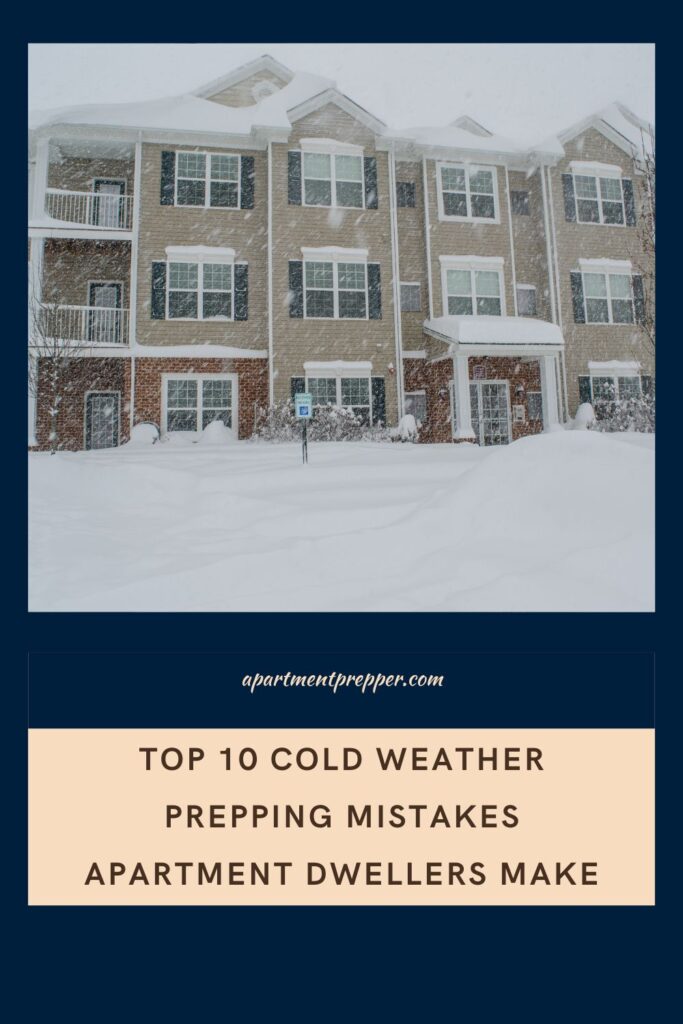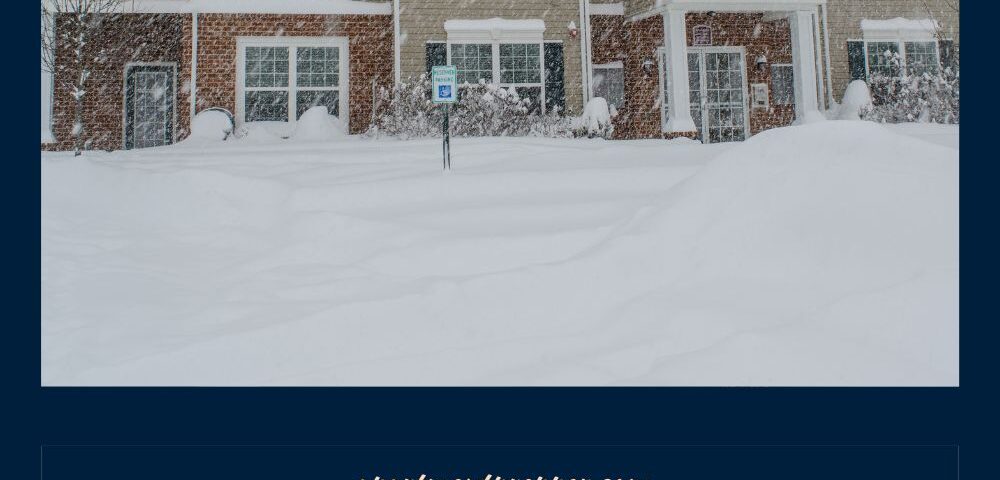Written by Bernie Carr
As the temperature drops and winter approaches, preparing your apartment for cold weather becomes essential for both comfort and safety. However, many apartment dwellers overlook key aspects of cold weather preparedness, leaving them vulnerable to power outages, frozen pipes, and other winter hazards. To help you avoid common pitfalls, we’ve compiled a list of the top 10 cold weather prepping mistakes apartment dwellers make—and how you can avoid them.
1. Ignoring Window Insulation
One of the biggest mistakes apartment dwellers make is failing to properly insulate windows. Many apartments have single-pane windows or poorly sealed windows that allow cold air to seep in, significantly increasing heating costs and reducing indoor comfort.
How to avoid this mistake:
- Use weatherstripping or foam tape to seal any gaps around window frames.
- Install window insulation film or thermal curtains to prevent heat from escaping.
- For a temporary solution, you can place rolled-up towels or draft stoppers at the base of windows to block cold drafts. In a pinch, you can also try using bubble wrap, which worked well when we had a cold snap in Texas a few years ago.
2. Relying Solely on the Building’s Heating System
Many apartment dwellers assume that their building’s central heating system will be sufficient to keep them warm during winter. However, if the system breaks down or if the power goes out, you could be left without heat for hours or even days.
How to avoid this mistake:
- Invest in a portable space heater (electric or propane) as a backup heat source, but make sure it’s safe for indoor use.
- Stock up on warm blankets, thermal clothing, and sleeping bags rated for cold weather. During very cold weather, we place sleeping bags on our bed to increase warmth.
- Learn how to layer your clothing to maximize warmth without relying entirely on your heating system.
3. Not Storing Enough Water
Cold weather can lead to frozen pipes, which means you may be left without access to running water. Apartment dwellers often overlook the importance of storing water for emergencies during winter months.
How to avoid this mistake:
- Store at least one gallon of water per person per day for at least three days.
- Keep water in sealed containers in a cool, dark place. You can repurpose clean bottles or purchase inexpensive water storage containers.
- Consider keeping a small water filtration system or water purification tablets in your emergency kit.
4. Forgetting to Prepare for Power Outages
Power outages are common during winter storms, and apartment dwellers often fail to prepare adequately for these situations. Losing electricity can affect heating, lighting, cooking, and communication.
How to avoid this mistake:
- Invest in a battery-powered or hand-crank emergency radio to stay informed about weather updates and safety information.
- Stock up on flashlights, batteries, and LED lanterns. Avoid using candles, as they can be a fire hazard.
- Purchase a solar charger or portable power bank to keep your phone and essential devices charged in case of an outage.
- Have ready-to-eat, non-perishable food on hand that doesn’t require cooking or refrigeration.
5. Neglecting to Check for Carbon Monoxide Risks
Carbon monoxide (CO) poisoning is a serious risk during the winter, especially when using space heaters, gas stoves, or any other fuel-burning appliances. Apartment dwellers who overlook CO safety may unknowingly put themselves at risk.
How to avoid this mistake:
- Install a carbon monoxide detector in your apartment, especially near bedrooms and living areas.
- Never use gas stoves or grills as heating sources inside your apartment.
- Ensure that your space heater or any other gas-powered devices are designed for indoor use and have proper ventilation.
6. Failing to Winterize Your Emergency Kit
Many apartment dwellers have an emergency kit but fail to update it with cold weather essentials. A standard emergency kit may lack the necessary items to help you stay warm, hydrated, and safe during freezing temperatures.
How to avoid this mistake:
- Update your emergency kit to include thermal blankets, hand warmers, and warm clothing.
- Add extra batteries for flashlights and any electronic devices you may need during a power outage.
- Stockpile non-perishable, high-calorie foods that provide energy and warmth, such as nuts, protein bars, and canned soups.
- Keep extra socks, gloves, and hats in your kit to prevent frostbite if the indoor temperature drops.
7. Not Taking Care of Frozen Pipes
Frozen pipes can burst and cause severe water damage, but many apartment dwellers don’t take preventive measures to avoid this problem. If the water in your pipes freezes, it can expand and cause the pipes to crack or burst, leading to expensive repairs.
How to avoid this mistake:
- Let cold water drip from your faucets during extremely cold weather to prevent pipes from freezing.
- Open kitchen and bathroom cabinet doors to allow warm air to circulate around plumbing fixtures.
- If your pipes are prone to freezing, wrap them in pipe insulation or use heat tape to keep them warm. We’ve also wrapped them in bubble wrap using duct tape in previous years when we didn’t have insulation or heat tape.
8. Overlooking Window and Door Drafts
In many apartments, doors and windows don’t seal properly, which allows cold air to enter and warm air to escape. Ignoring these drafts can make your apartment feel colder and increase your heating costs.
How to avoid this mistake:
- Use draft stoppers at the base of doors and windows to block cold air from entering.
- Apply weatherstripping around doorframes to seal any gaps.
- Use thermal curtains on windows to provide an extra layer of insulation and block cold air from entering.
9. Not Being Prepared for Ice and Snow
Many apartment dwellers forget to prepare for icy conditions around their buildings, such as sidewalks, steps, and parking lots. Slippery surfaces can lead to accidents and injuries.
How to avoid this mistake:
- Keep a bag of rock salt or sand on hand to sprinkle on icy sidewalks or steps.
- Invest in non-slip snow boots or ice cleats to safely navigate icy surfaces.
- Store a shovel or ice scraper in your car for quick removal of snow and ice if you need to drive during bad weather.
10. Not Communicating with Your Landlord or Neighbors
In apartment living, it’s easy to assume that the landlord will take care of everything, but during extreme weather, it’s essential to stay proactive and communicate with your landlord or property manager about necessary maintenance or repairs.
How to avoid this mistake:
- Notify your landlord about any drafts, leaks, or issues with the heating system well before cold weather arrives.
- Ask your landlord about the building’s emergency protocols, such as what to do if the heating system fails or if there’s a power outage.
- Stay in touch with neighbors, especially if they’re elderly or have limited mobility, and work together to check on each other’s well-being during severe weather events.
Conclusion
Cold weather prepping as an apartment dweller presents unique challenges, but with the right strategies, you can avoid common mistakes and keep your home safe and warm throughout the winter months. By insulating your windows, preparing for power outages, storing enough water, and winterizing your emergency kit, you’ll be ready for whatever the winter season throws your way. Don’t wait until the first cold snap to start prepping—get started now and ensure that you’re prepared for any cold weather emergencies.
We are an affiliate of Amazon.com, which means we received a small commission if you click through one of our Amazon links when you shop, at totally no cost to you. This helps keep the lights on at the blog. Thanks!
About the author
Bernie Carr is the founder of Apartment Prepper. She has written several books including the best-selling Prepper’s Pocket Guide, Jake and Miller’s Big Adventure, The Penny-Pinching Prepper and How to Prepare for Most Emergencies on a $50 a Month Budget. Bernie’s latest e-book, FRUGAL DIY has just been released on Amazon. Her work appears in sites such as the Allstate Blog and Clark.com, as well as print magazines such as Backwoods Survival Guide and Prepper Survival Guide. She has been featured in national publications such as Fox Business and Popular Mechanics. Learn more about Bernie here.
FB: https://www.facebook.com/apartmentprepper
Instagram: https://www.instagram.com/apartmentpreppers/
Twitter: https://twitter.com/AptPrepper
YouTube: https://www.youtube.com/channel/UC7vOtdbo-wiBeBxD6puCr1Q
Patreon: https://patreon.com/apartmentprepper
Pinterest: https://www.pinterest.com/aptprepper/
Today’s societal climate not supportive of prepping. With your help, we can keep bringing you content that is often suppressed. Help keep Apartment Prepper alive.
Join me on Patreon for ad-free content.




Good article. Well worth some study. On the topic of lighting, did you know that Eveready, Rayovac, Dorcy, and Ozark Trail all make flashlights that run on just ONE D-cell. Details (model numbers, etc.) are shown in my write-up — https://www.youtube.com/watch?v=kv7Bx6usT-g. Actually, a flashlight model that requires only one battery can be found for just about every battery size (AA’s, AAA’s, square 9-volt, etc.). Check it out.
It’s a good idea to keep flashlights that run on just ONE D-cell. Thanks Ron!
The specific model-number listings start at minute 2:18 in the write-up.